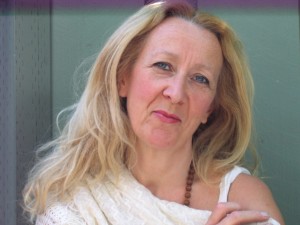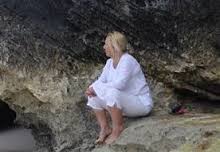Today, SevenPonds speaks with Camella Nair, (read part one of our interview here) a yoga teacher and swami born in England and based in California, about her spiritual journey through yoga over the past 30 years. Camella is certified in death midwifery and certified as an Ayurvedic health educator and an Ayurvedic yoga teacher. Camella shares her insights on the yogic path and accepting impermanence.
Ellary: Will you talk about the Death Insight and Conversation deck of cards you created?
Camella: I developed the Death Insight and Conversation Cards after my training in home funerals with Jerrigrace Lyons in Sebastopol, California. Her organization is called Final Passages, and she’s done a marvelous job training people in home funerals, something that we used to do for thousands of years before all of a sudden we start to get a distaste for caring for our dead. Now it’s become an institution that takes care of our beloveds and we become even more detached from the process of death and dying. We have to pay to see them when we have funerals and things like that. Those cards came very, very quickly as I was finishing my training.
Ellary: It’s a deck of cards, right?
Camella: Yeah, a deck. You use them probably the same way that you would use a tarot deck or something like that. You can either play it when a group of people come together or you can just shuffle them and pick a card whenever you want to, every day or once a week, and just see what comes up for you. It’s like a soul collage. You put yourself in the picture with whatever symbols are there; you actually put yourself in the picture and see what comes up. It’s a fascinating process, actually. Last Thanksgiving, I cooked for my boys and one of their girlfriends, and after dinner I got the deck out and I said, “I’d like to play with this deck with you if that’s OK.” And they said, “Ooh, hmm. Well, alright then, mom.” And the insight that they had was fantastic. It was amazing. We’re always worried about our children, that we’ve got to shelter them, and hide them from things. I mean, my boys are 19 and 22 now, so they’re not young, but I think we always have the desire to shelter our kids from things. They can just offer so much wisdom and clarity about things that our parents can feel really fearful of and become really emotional about. But the time to talk about it is before calamity sets, because we know that the onset of death can tear families apart.
Ellary: Especially if there’s been no preparation for it, emotional or logistical.
Camella: Exactly. You know you’ve got to deal with the grieving process of losing somebody. At the same time you’ve got to figure out, “What do they want, and have I done the right thing?” and then go through all of that logistical stuff. And it’s wasted energy that we could use to help people transition. I think because of the way that we’ve been taught and institutionalized by religion, we think that there’s gonna be some punishment, some penance to pay when we die. So I think one of the greatest things that we can do to help anybody is to remind them of their good deeds. If we’re knee deep in trying to get funeral arrangements and sort out the payments and what’s going on in their lives on the logistical side, we’re not helping them on a spiritual level, on a deeper level helping them transition and find peace. And we can help them. We can expend our energy helping them transition to the next phase of their immortality and not have to deal with all the logistics of paperwork and other family members who might not agree with what we think. You can get all sorts of family arguments going on.
Ellary: Yeah if some of that is sorted beforehand then you have the energy to emotionally and spiritually support people. Going back to the Death Insight and Conversation Cards, what makes them death insight cards?
Camella: Well the mind doesn’t speak in English or Spanish or French or Sanskrit or Chinese or anything; it speaks in symbols. So the cards are all collages and pose questions that come out of our subconscious mind. They create discussion and insight about specific subjects. Some of the cards, I don’t know how they came about, it’s just one of those things. You open up to something and you don’t take credit for it necessarily. It just sort of evolves. It comes out of somewhere out of the universe. The process started by just gathering magazine cuttings and things, ripping them out and piecing them together until they form some picture, some image that speaks to us on some level. And so there are cards that represent death of a marriage, cards that represent death of our food chain. It’s not just about death and dying. There’s a fun card with women in flamboyant clothing, bright yellow clothing. It begs the question, “Would it be OK for you to wear colorful clothing, and invite your guests to a party for your funeral, or do you think it has to be somber just because that’s the way that your family has done it for generations, or that’s the way that you think society shows that you’re showing respect for that person?” So there are lots of different subjects that are covered, not just about death or dying, but with regards to how rigid we are. We all are. We’ve all got this personality, you know where we’re all stuck with our prejudices and our likes and our dislikes, stuff like that. It defines us, I think.
Ellary: Do you officiate many funerals?
Camella: Sadly not. I’m very busy and I think it’s important to specialize, have some focus. I did officiate a friend’s mother’s funeral some years ago, and that was before I did my home funeral training. I went to see the lady, and she’d been embalmed. When you see a dead body, its obvious that someone’s not in the building anymore. But then there’s the question of putting chemicals in them, you know it’s another of those processes. I think, “What are we doing it for? To try to make it more acceptable to view a dead body?” We can actually preserve bodies for quite some time, for a few days at least, on dry ice. And if we know the person, we know how they’re going to wear their makeup and their hair, what clothes they’re going to wear. I think that something that’s missing in our society is ritual and ceremony and that should be part of the sacred ritual and ceremony for family members that want to do it, of course. Not everyone’s going to want to do it. But a lot of people don’t know that they can do it, that they can have a home funeral, that they can dress the body, that they can bathe it at home and have a vigil, and come to terms with their loss that way. They don’t have to go to the crematorium and pay to have a viewing and a funeral and so forth, where bodies magically disappear behind the curtain. We’ve just outsourced that part of our life. And I don’t think people realize that they can actually have a home funeral.
Ellary: Is death something you talk about in your yoga classes?
Camella: Sometimes, yeah.
Ellary: How do people respond to it, generally?
Camella: Surprisingly well, actually. Now I’m teaching a lot of restorative classes, which I really love. You actually don’t teach much. You create an environment where people can just go deeply into a sense of letting go and deep relaxation. When people come and they’re in chronic pain, it’s helpful. We’re all so caught up in doing stuff; even in yoga, we’re caught up with being strong, being bendy. What we’re really doing in yoga is getting rid of stuff, and no more so than in restorative yoga. The people that come to those kind of classes tend to be people in some sort of rehab, or they’re older and they don’t necessarily want to do all the rest of it; they want to have a nice relaxation. They’re usually open to any suggestion of talking about finality or the changes in seasons, the circadian rhythms and things.
Ellary: I’ve heard that one of the ways that asanas (physical yoga poses) can train us is by preparing us to endure other uncomfortable situations. By breathing through the discomfort of a particular pose, you are sort of training and preparing yourself for future hardships, both emotional and physical.
Camella: Yeah, you see people who have injured themselves and are having an operation and don’t want to take medication, just want to breathe through it and use all the skills they learned in yoga, and I suppose that does have an effect, definitely. I teach prenatal yoga as well and what I’m teaching the girls is to focus a lot on the exhale and just letting go, because so much emphasis in the past has just been to screw your face up and make it look like you’re pushing really hard. We don’t train women to prepare for an active childbirth at all. Even in the yoga world, we’re teaching poses for the first, second and third trimester rather than focusing on this whole process of life-changing experience that can actually be rather like the outer fringes of samadhi. When you get to that second phase, that transitory phase when things are really happening, it is like an out of body experience. Sadly, most women are really not prepared, other than talking about kegels and things like that and what medications they’re going to go on and how quick the baby’s going to come out. People don’t treat the whole experience as something positive, you know? They still use the word pain for labor, instead of choosing a word without a negative association, like intensity or something like that.
Ellary: Yes, it’s important to pay attention to the charge of certain words and the shifting our experience just based on how we name it. It must be really rewarding to work with pregnant women.
Camella: Oh, it is. Yeah, there was a girl in the training this weekend that was six months pregnant. It’s such a no-brainer when you think about it, because her body’s growing, and the baby’s in a water environment. All of our bodies are in a water environment, and then you take your yoga practice into a swimming pool, and it’s just fantastic.
Ellary: Have there been any books in particular around death and dying, or any yoga books related to loss and grieving and clinging and attachment that have been particular poignant and impactful for you?
Camella: Studying the Yoga Sutras of Patanjali has really helped me. Honestly for me it was studying the Yoga Sutras and really getting that we’re supposed to come to terms with our temporality in the physical body and the fact that we’re immortal and we never die. I liked what Goswami Kriyananda had to say. He actually left his body earlier this year. I always thought that maybe I’d get to see him again before he died, but didn’t, unfortunately. I was talking to some students shortly afterwards, and they asked what Kriyananda was doing now, and I told them that he’d left his body. They said they were sorry and I said, “You know what? I have to be really strong because I remember him saying years ago, ‘Don’t grieve my death, otherwise you defame my teaching, and you haven’t listened to anything I’ve told you about the temporality of the physical body, and the fact that we’re immortal.'” It helped, because it’s like a losing a grandfather and a grandfather’s spiritual teachings.
You think you’re never going to see them again, but of course you are. Even this weekend when I was teaching and I was talking — obviously when you’ve been with someone for so long, listening to them, you find yourself saying words and it’s like they’re saying them, you know what I mean? And so he was there. It was like he was there. It’s the same when we lose a family member or a friend. We’ll say something or do something or look at something and it’ll bring back a memory, and they’re with us. Those whose hearts and minds are one are never apart. I find him and anyone that I’ve lost over the years in meditation, contemplation, staring at a lovely sunset or something. You know, they’re always with us. Like thoughts.
Ellary: Thank you so much, Camella, for taking the time to speak with us. It was a privilege hearing your insight.
Camella: Thank you!

 How Can Yoga Help Us Confront Death? An Interview with Camella Nair, Part Two
How Can Yoga Help Us Confront Death? An Interview with Camella Nair, Part Two





 “Making Mobiles” by Karolina Merska
“Making Mobiles” by Karolina Merska
 “Hands Up to the Sky” by Michael Franti & Spearhead
“Hands Up to the Sky” by Michael Franti & Spearhead
 Coping With Election Grief
Coping With Election Grief














